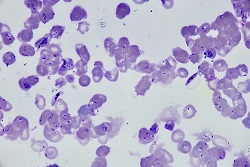SPARk project sheds light on sexual differentiation process in P. falciparum
Plasmodium falciparum is responsible for over 75 % of malaria cases in Africa, and it’s also the deadliest form of the disease. But what makes it particularly renowned – or rather, intriguing – within the scientific community is its complex life cycle: During the 14 days after one gets bitten by an infected female Anopheles mosquito, liver-stage parasites will differentiate and undergo asexual multiplication, resulting in tens of thousands of merozoites that burst from the hepatocyte and invade red blood cells. Whilst some of these merozoites divide into schizonts, others turn into sexual forms of male and female gametocyte that are taken up by female Anopheles mosquitoes during their blood meal. But although the process is well known, the mechanisms that see parasite transformation into specialised stages capable of sexual development are still poorly understood. As she studied gametocytogenesis at the Harvard School of Public Health, Dr Kathrin Buchholz made a breakthrough by identifying pathways specifically upregulated at the onset of sexual differentiation. She found that four genes involved in different aspects of post-transcriptional gene regulation were highly upregulated, and decided to go further in the analysis of this aspect of gametocyte biology thanks to funding under the SPARk (Adding Pieces to the Puzzle of Sexual Differentiation In P. falciparum: A Systematic Analysis of RNA Processing) project. As the project comes closer to its end, Dr Kathrin Buchholz agreed to discuss her approach and how her research may eventually contribute to improved health conditions in malaria-endemic countries. Why is parasite transformation into gametocytes so important to study? Most currently-used antimalarials target the parasite stage responsible for the symptoms and the mortality of the disease – the asexually-replicating parasites. But the parasites responsible for completion of the life cycle in the mosquito vectors are the gametocytes. To combat malaria on a global scale, it is necessary to include intervention strategies against gametocytes, since these are the stages responsible for the spread of the disease. With this project, we hope to lay a basis for novel transmission-blocking intervention strategies. Which knowledge gaps did you specifically aim to close and why? The different gametocyte stages are accompanied by distinctive patterns of sexual-stage specific gene expression. In recent years, our understanding of sexual commitment and gametocyte biology has become more detailed. This is true especially when it comes to understanding the molecular mechanisms leading to sexual commitment. However, major knowledge gaps remain, such as details on how external stimuli translate into sexual commitment in Plasmodium and further downstream molecular processes, after commitment but early in the Plasmodium sexual life cycle. With the SPARk project, I aimed to gain a more detailed understanding of these early events. How did you proceed to do so? To gain more information about the importance of the genes selected in this project for sexual differentiation in Plasmodium, I used a knock down approach. The so-called destabilising domain (DD) system enables regulation of protein levels. DD-fusion proteins are expected to rapidly degrade in the absence of a ligand, and stabilise in its presence. Transgenic parasite lines were generated and add this domain to the genes I was interested in. A major advantage of this system is that it lays a good basis for future pharmacological intervention. This type of method allows for choosing genes with an essential phenotype upon a 70-80 % reduction in protein level (each gene will exhibit its own level). These are levels that can also be reached later with pharmacological intervention. What would you say were your most important findings? SPARk aimed at dissecting the functions of four genes in sexual development. All genes had predicted functions in controlling gene expression. It appears at the moment that two out of the four genes have an important phenotype with an overall reduced number of gametocytes. However, since reverse genetic approaches in Plasmodium take a long time and can be prone to technical difficulties, we are in the process of verifying these findings. What kind of new treatments could this project lead to? There is one approved drug that is part of the WHO recommendation for treating malaria as a gametocidal component: primaquine. But use of this drug is hampered by side effects and it cannot be used in all patient groups. Therefore, there is an urgent need for target-based drug development directed against P. falciparum gametocytes. If we could describe genes with a validated importance for Plasmodium gametocyte development, this would allow us to proceed with the development of novel inhibitors. The recombinant protein of this validated gene could then be recombinantly expressed, a high throughput compatible assay could be established, and inhibitors could be screened. Ideally, this would result in a specific inhibitor that acts solely on the validated target. Besides potential treatments, what do you hope will be the impact of the project? Beside the potential of this project to lead to validated targets for rational drug development, we aim at gaining a better understanding of the molecular mechanisms that happen during sexual development in malaria parasites. Specifically, we hope to describe novel mechanisms that could increase our knowledge of how Plasmodium parasites orchestrate complex genetic switches and modulate the cellular response to developmental signals. Do you have any plans for follow-up research? Yes, the next steps are to proceed with the outlined strategy for rational drug development, e.g. work with recombinant proteins and inhibitor screening. Additionally, we will also try to gain a better understanding of the importance of these genes on a molecular level. Furthermore, the project served as an establishment of the necessary methodologies, and I have already included more genes (e.g. metabolic enzymes) in the work pipeline.
Countries
Germany



